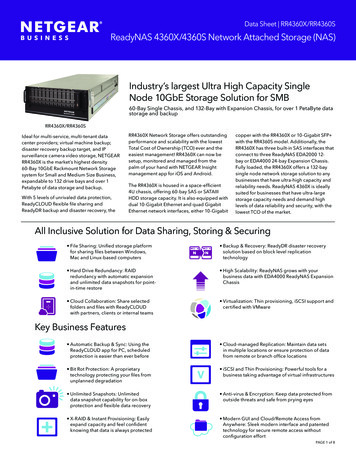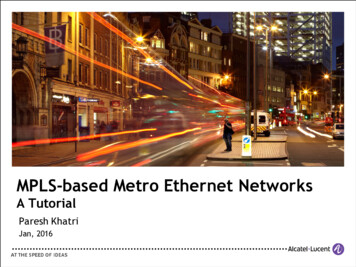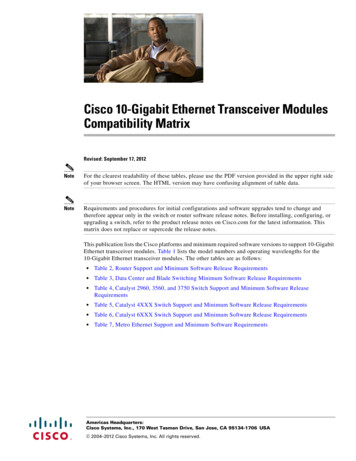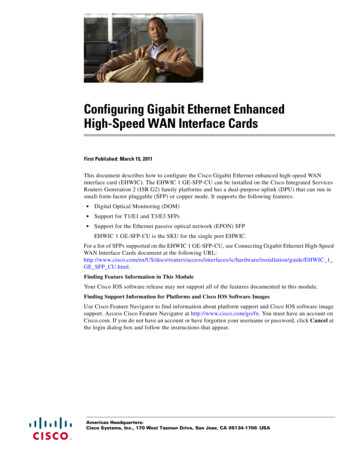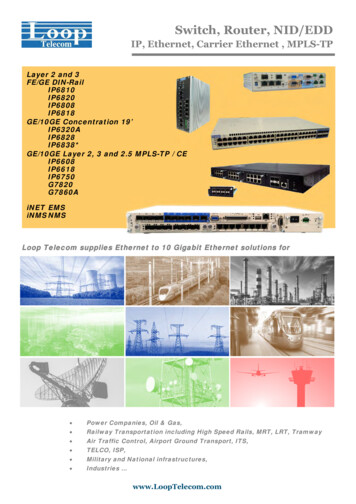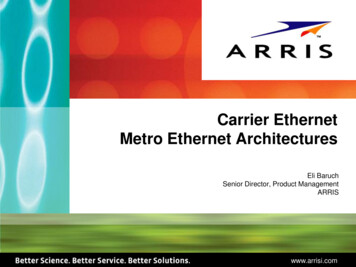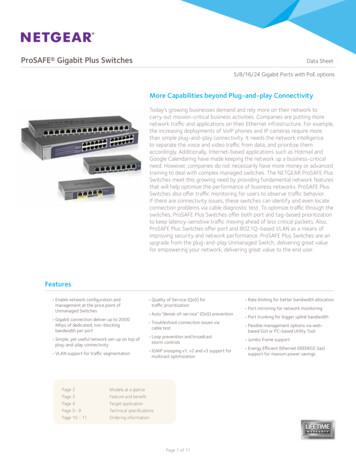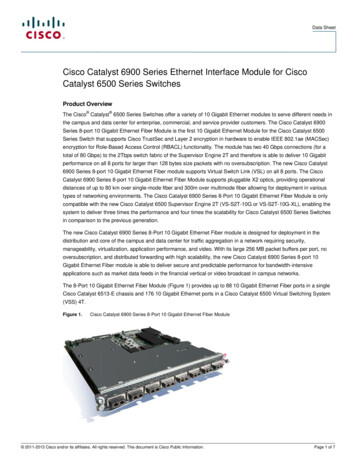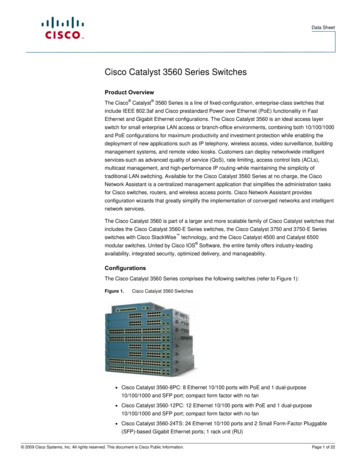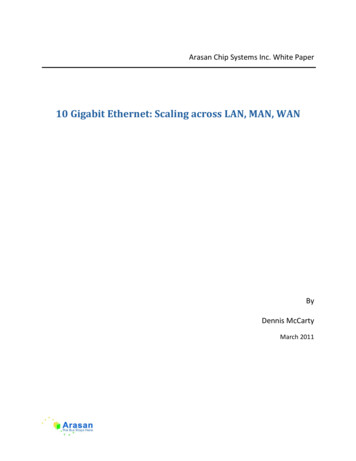
Transcription
Arasan Chip Systems Inc. White Paper10 Gigabit Ethernet: Scaling across LAN, MAN, WANByDennis McCartyMarch 2011
10G Ethernet TechnologiesOverviewEthernet is one of the few protocols that has increased its bandwidth, while retaining its basicfunctional characteristics such as Layer 2 protocol, frame format, packet oriented, non‐guaranteed delivery. As the capability to drive signals faster over both copper and fiber mediahas increased due to advances in circuit design and process technology, Ethernet too has seenits capabilities extend beyond the ubiquitous triple speed (10/100/1000 Mb/s) MAC to 10 Gb/sand beyond.The 10 Gigabit Ethernet standard is specified in IEEE 802.3ae 2002 and its most recentamendments (2008). With rapidly changing patterns of computing shifting between “thick” to“thin” clients, powerful workstations to centralized servers, and advancing regulatoryrequirements for data backup, Ethernet has been extended to support many applications.The increase in affordable computing and multimedia processing in both home and enterprisesystems has resulted in the explosion of data generated and consumed in public and privatenetworks. Ethernet plays a vital role in delivering this data end‐to‐end and providing a commonbackhaul for interconnect and data backup as shown in Figure 1.In this whitepaper, we present some of the market drivers for the next generation of higherspeed Ethernet ‐ 10 Gigabit Ethernet.Figure 1: 10 Gigabit Ethernet deployment beyond traditional LAN environmentArasan Chip Systems Inc.2
10G Ethernet TechnologiesTrends Driving 10 Gb/s Ethernet AdoptionThe rapid digitization of multi‐media has resulted in more packet‐oriented data traffic than everon networks. While consolidation of multiple networks onto the ubiquitous Ethernet platformhas been forecasted for a while, 10 Gigabit Ethernet offers the first opportunity for suchnetworks can be cost‐effectively realized. The convergence of multiple applications ontoEthernet, coupled with its increasing bandwidth and transportable distance make 10 Gb/sEthernet the ideal choice for a common backhaul infrastructure.Enterprise network managers can use 10 Gigabit Ethernet to scale across building, campus andremote offices (within 40 km radius) – without the need to translate Ethernet frames along theway. This helps them preserve their investment in Ethernet technologies while reducing thecost of deploying the network. 10 Gigabit Ethernet is the first networking technology thatencompasses LAN, MAN and now even WAN links. The versatility simplifies campus widenetworking – permitting a single standard to serve workgroup, intra‐building, inter‐building andcampus‐wide secure networks.The increase in network traffic is also driven by the rapid adoption of 1 Gb/s Ethernet, furtherfueling the deployment of 10 Gb/s Ethernet for traffic aggregation and storage applications.The increase in client / server computational loads necessitates the bulk transfer of data acrossa network. Enterprise‐wide operations such as backup, recovery and remote data managementcan be deployed using 10 Gb/s Ethernet, with minimal impact to network latencies. All of thesenetwork uses strain the current 1 Gb/s Ethernet connectivity and hence greatly benefit fromthe upgrade to 10 Gb/s Ethernet.10 Gigabit Ethernet preserves many of the characteristics of the original Ethernet protocol andmany vendors offer interoperable equipment. This compatibility reduces the cost of thenecessary infrastructure – from cabling to host bus adapter cards and active networkcomponents lowering the cost of deploying 10 Gb/s Ethernet. Enterprise and service providersare assured of multiple, inter‐operable sources of 10 Gb/s Ethernet infrastructure, eliminatingany potential lock‐in with equipment provider.Arasan Chip Systems Inc.3
10G Ethernet TechnologiesFigure 2: 10 Gigabit Ethernet ProtocolThe key aspects of 10 Gigabit Ethernet protocol as shown in Figure 2 are: Increased bandwidth up to 10 GbpsFull‐duplex operationNo CSMA‐CD neededPacket format are backwards compatibleIncreased physical network range10 Gigabit Ethernet also permits Internet Service Providers (ISPs) and Network ServiceProviders (NSPs) to easily connect equipment using a short, high‐speed interface between co‐located carrier grade switches and routers. The interface enables ISPs to provide faster accesswithout the latencies associated with format translations.10 Gigabit Ethernet is thus the first technology that enables the convergence of different traffictypes – data, voice, multi‐media onto an all‐IP and Ethernet platform.10 Gb/s Ethernet ProtocolThe 10 Gigabit Ethernet protocol was first ratified in June 2002, as the IEEE 802.3ae‐2002. Thisstandard extends the basic behavior of Ethernet to a bandwidth of 10 Gb/s in Full duplex mode.In full‐duplex there are no packet collisions that can occur. Packet formats are unchanged in 10Gb/s Ethernet.Arasan Chip Systems Inc.4
10G Ethernet TechnologiesEthernet is a Layer 2 protocol in the networking stack as defined by the Open SystemsInterconnection (OSI) model. 10 Gigabit Ethernet uses the same IEEE 802.3 Ethernet MACprotocol, frame format, frame sizes, and is a connection‐less, non‐guaranteed packet deliveryprotocol.Several physical media are available – that extend all the way to WAN type of links. 10 Gb/sEthernet defines two types of PHYs: a LAN PHY and a WAN PHY. The latter permits connectionsto SONET STS‐192c/SHD VC‐4‐64c networks. Both copper and fiber PHY media are supported.10 Gigabit Ethernet MAC defines a 74 signal, parallel XGMII bus to interface with a PHY. To easesystem design, a new interface called XAUI has also been specified. This serves as an alternativeto the parallel XGMII bus which is difficult to place and route on a PCB. XAUI is a high‐speed,low‐pin count differential interface, which eases PCB layout and component location.The features and benefits are summarized in Table 1.10 Gb/s Feature10 Gbps peak bandwidthFull‐duplex operation onlyNo CSMA‐CD functionPacket format backward compatibilityIncreased physical network rangeEnablesScale to meet bandwidth needs of nextgeneration Enterprise Apps and StorageFaster sync and two‐way communicationSimplifies protocol, reduces overhead andeliminates re‐transmissions due to collisionsMaintain application layer interface andinvestment in network software stacksExtend Ethernet into campus, metro and widearea networksTable 1: Overview of new features in 10 Gigabit Ethernet and their benefitsA variety of media types are supported for physically transporting 10 Gigabit Ethernet framesover the PHY (Layer 1) layer. Due to the full duplex nature of traffic, the range of 10 Gb/s isextended significantly in this standard (refer to Table 2).PHY ‐LR10GBASE‐ERRange15m26m300m10km40kmTable 2: Physical network reach for 10 Gigabit EthernetArasan Chip Systems Inc.5
10G Ethernet TechnologiesTraffic Consolidation on 10 Gb/s EthernetEnterprise and service provider network architects so far had to rely on a complex set ofnetworking technologies to provide end‐to‐end services to their customers. Ethernet, OC‐12,OC‐48, SONET, SDH, and packet over SONET/SDH are some of the technologies that theseproviders had relied on.With Ethernet being the de‐facto standard inside the Enterprise, an entire range of devicesfrom simple switches to intelligent Ethernet based multi‐layer switches have proliferated.Service providers would like to extend this network architecture to cover intra‐campus andultimately inter‐campus internetworking.Ethernet has scaled both in bandwidth (10 Gb/s) as well as physical range (over 40 km), whilepreserving the frame formats and other features of the protocol. Hence, Enterprises cancontinue to benefit from their investments in Ethernet such as – operator training, higher layerprocessing such as routing, caching, server load balancing and policy based intranets. Now, with10 Gb/s Ethernet, these same functions can be supported for traffic in LAN, MAN and evenWAN.The convergence of both media (voice, video) and data onto packet switched networks usingTCP/IP running over Ethernet is now a reality, with all parts of this ecosystem in place. Thepromise of convergence can finally be realized with 10 Gigabit Ethernet.Figure 3: Convergence of Voice, Data, Multi‐media onto a common IP / Ethernet platformArasan Chip Systems Inc.6
10G Ethernet TechnologiesArasan’s Ethernet IP PortfolioArasan Chip Systems, Inc has been a leading developer of Ethernet IP offering comprehensivesolution from 10, 100 Mb/s, 1000 Mb/s up to 10 Gb/s. The total solutions have been used indiverse applications ranging from custom networking ASICs to high‐performance Ethernetsystems. Ethernet cores enhanced to support IEEE 1588 Real‐time Transport protocol are alsoavailable. For 10 Gb/s Ethernet, Arasan has also developed a XAUI IP and a 64B/66B PCS IP thatcan be separately licensed. Arasan provides a Total IP Solution for Ethernet consisting of fully‐compliant, silicon‐verified IP cores, verification IP, portable software stacks and hardwaredevelopment platforms, backed by our World‐class customer support.Summary10 Gigabit Ethernet provides the necessary performance at the right cost point to facilitate theconvergence of diverse network traffic onto a common IP / Ethernet platform.The ten‐fold increase from 1 Gb/s Ethernet, allows it to support next generation Enterpriseapplications with ease. Network operators benefit from economies of scale by having tomanage a single network protocol that can handle diverse types of network traffic.The increase in its range, supported by fiber media, allows this ubiquitous interface to scaleacross small to mid‐size campuses. The higher bandwidth permits storage access and backupoperations to be supported on the same network.With its portfolio of Total IP Solutions for Ethernet, Arasan eases the integration of this high‐performance interface in complex networking ASICs and chipsets.Arasan Chip Systems Inc.Data Sheets Link:2010 N. First Street, Suite510, San Jose, CA ne: 408‐282‐1600Fax: 408‐282‐7800Email: sales@arasan.comFor a complete directory of ArasanIPproducts,pleasevisit:www.arasan.comArasan Chip Systems Inc.7
OC‐48, SONET, SDH, and packet over SONET/SDH are some of the technologies that these providers had relied on. With Ethernet being the de‐facto standard inside the Enterprise, an entire range of devices from simple switches to intelligent Ethernet based multi‐layer switches have proliferated.
